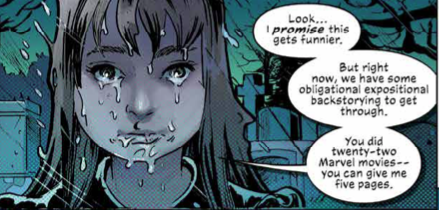M.O.M.: Mother Of Madness #1 // Review
Meet Maya Kuyper. She’s chatty. She’s witty. She’s dizzyingly articulate. And she’s got a host of superpowers that are tied into her overall emotional state. She’s the subject of the endearingly satirical new mini-series M.O.M.: Mother Of Madness. Writers Emilia Clarke and Marguerite Bennett pack the first issue of the three-issue series with impressive detail that renders a very believable world just a few decades from now. Artist Leila Leiz and colorist Triona Farrell deftly slide between casual comedic drama and a fantastic superhero origin story.
Maya greets the reader in the very first panel. It turns out she’s at a party. She immediately starts giving the reader a tremendous amount of information about herself. She was born last year, and she’s drinking a martini. It’s okay, though: the party is taking place in 2049, and she’s got a whole life story that she’s more than happy to talk about. Early on, she leaves out one rather big detail. Chemical exposure at an early age gave her superpowers that manifest based on emotional state. If she’s strong. If she’s anxious, she’s got super-hearing. If she’s frightened, she becomes invisible. And that’s not even the half of it...
With captivating humor, Clarke and Bennett fuse a Silver-Age-style superhero origin with an indie comedy personality that directly addresses the reader and breaks the fourth wall. Clarke and Bennett adroitly shift from comedy to tragic reality in a way that keeps the funny stuff funny without compromising the heaviness of the drama. The world of M.O.M.’s 2049 is a satirical amplification of current society that might feel a bit flat in places. Still, the charmingly intricate complexities of Maya ARE the center of the story, and it’s very, very difficult not to feel very close to the character by the end of the first issue.
The visual world of M.O.M is as richly detailed as Clark and Bennett’s script. Leiz and Farrell lend the story deeply expressive art that is as interesting in a lab environment as it is at home, in an office, or in an apartment across town. Leiz renders things with a very clever line economy that occasionally feels a bit drippy when it could be tight. Farrell’s colors lend depth and atmosphere to the page the cuts some of the harder edge that might have otherwise been present in the darker edge of the story. Farrell intensifies the visuals beautifully whenever Maya’s powers reveal themselves.
So...the series is already 1/3 over. It’s a bit difficult to accept this, given how good the opening issue is. Clarke, Bennett, and company have done such a good job of putting together a genuinely engaging fusion between satire, emotional drama, and traditional superhero story that it seems a bit tragic that it’s only going to be around for a couple more months. Maya is such a fascinating person. It’s too bad she’s going to disappear not too long after summer. Maya’s just getting started in her crimefighting career, and there are only two issues left. It’ll be interesting to see where Clarke and Bennett take her in the final two issues of the series.










